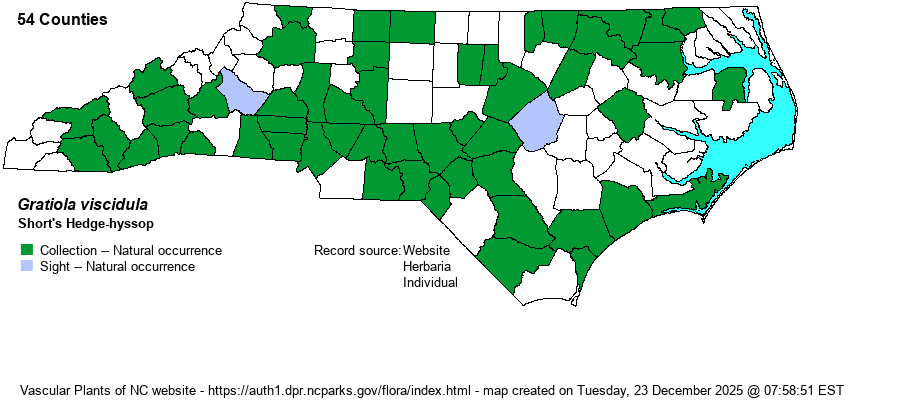| Author | Pennell | |
| Distribution | Scattered across the entire state, but with many gaps in the range, particularly in the northern Mountains and parts of the Coastal Plain.
This species has a small range centered in the mid-Atlantic states; ranging from MD to southern IA, south to northern FL and AL. Most records are from eastern VA to SC.
| |
| Abundance | Despite collections and other records from slightly over half of the state's 100 counties, this is far from a common species; both G. virginiana and G. neclecta are seen much more often that this species. In general, it is uncommon across the Mountains and Piedmont, and infrequent in parts of the Coastal Plain. It seems to be rare, however, in the far eastern counties, and very rare to absent in the northern mountains. The NCNHP's State Rank of S2S3 is too conservative, especially with specimens from over 50 counties that are spread across the state. This website suggests an S3, if not S3S4, rank. | |
| Habitat | Though a wetland species like all of the Gratiola in NC, this species tends to prefer sunnier and thus more open habitats than those. It grows mostly along the margins of marshes, in ditches, along margins of Coastal Plain ponds, and in montane bogs. It is less often found near or in swampy openings than most others. | |
| Phenology | Blooms from June into November, and fruits shortly after flowering. | |
| Identification | This is a erect or leaning herb, growing mostly to 8 inches tall, but can grow to 1 foot long or more. As with G. virginiana, it has a wide, succulent stem, about 1/10-inch wide, noticeable in binoculars or a camera. The leaves are in scattered pairs, opposite and sessile, clasping the stem. Each leaf is ovate and about 3/4-inch long and about 1/2 as wide, with small teeth along the outer half of the leaf. From the middle and upper axils grow the solitary flowers, each on a very slender pedicel about 4/5-inch long -- longer than the leaf just below it. The flower is white (rarely very pale violet), tubular, and about 1/2-inch long. Thus, in summary, identify this hedge-hyssop by a combination of a succulent/wide stem, clasping ovate leaves, and a long flower stalk (slightly longer than a leaf). In reality, this species can be more easily confused with one or two species of Lindernia, though they tend to be smaller and have very slender stems. Despite the large number of collections, this is not a familiar species to most biologists, and this suggests a decline in its numbers now. | |
| Taxonomic Comments | None
| |
| Other Common Name(s) | Viscid Hedge-hyssop | |
| State Rank | S2S3 [S3S4] | |
| Global Rank | G4G5 | |
| State Status | | |
| US Status | | |
| USACE-agcp | OBL link |
| USACE-emp | OBL link |

